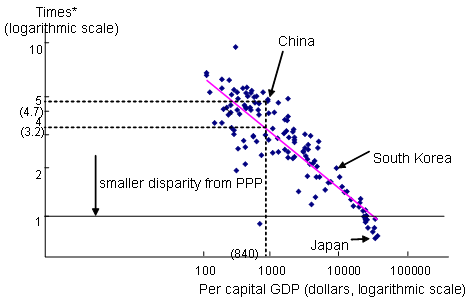Led by Finance Minister Masajuro Shiokawa, Japanese policymakers are calling on China to appreciate the yuan. One reason for this is that the yuan's current exchange rate does not accurately reflect the real strength of the Chinese economy, as can be seen by the huge difference from its purchasing power parity (PPP). So then, what is the theoretical value of the yuan from the viewpoint of PPP, and how far is it from the current exchange rate? Also, how large is China's gross domestic product when based on PPP?
PPP is the idea that exchange rates are, or should be, determined so that the "law of one price" holds. In a world where there is only one good, calculating PPP is extremely simple. In fact, every April The Economist calculates the purchasing power parity of each country's currency based on the price of a Big Mac. For example, if a Big Mac costs ¥130 in Japan and $1 in the United States, the purchasing power parity of the yen is $1=130. If the nominal exchange rate is ¥120 to the dollar, it is ¥10 higher than its purchasing power parity.
In the real world, theoretical PPP largely differs depending on how broadly the items used in the calculation are taken, since there are tens of thousands of goods, as well as services that are not directly exposed to international competition. According to estimates in the 2002 version of the World Bank's World Development Report , which is most often quoted when discussing PPP, prices in China are only 21 percent of those in the U.S. when converted using the current exchange rate of 8.28 yuan to the dollar, and toequalize the price levels between China and the United States, the yuan must appreciate to 1.74 to the dollar (8.28 x 0.21). In other words, if prices in the U.S. are the standard, PPP holds when the yuan is at 1.74 to the dollar - 4.7 times the actual exchange rate.
However, it has been observed that the lower the income levels in a developing country, the lower the exchange rate of its currency compared to its PPP, and China is no exception. This reflects the "Balassa-Samuelson effect," which states that even if the law of one price generally applies to tradable goods such as industrial products, most services, which are non-tradable goods, are cheaper in low-income countries as they reflect differences in wage levels. This observation indicates that the disparity between a currency's exchange rate and its theoretical PPP will narrow as that country's economy develops, and when it approaches the level of industrialized nations, its exchange rate converges to a level that generally matches its PPP. ( diagram )
Therefore, the disparity between the yuan's nominal exchange rate and its theoretical value in terms of PPP can be broken down into factors that are in proportion to its current stage of economic development and factors that are unique to China. In fact, when we look at the average figures for countries that are at the same stage of development as China (with per capita income of $840), price levels are 31 percent of those in the U.S., and theoretical PPP is 3.2 times the actual exchange rate (1 / 0.31). Even compared with this, China's prices are another 32 percent (1 - 0.21/0.31) cheaper. When set against the price levels of countries at a similar development stage (instead of that of the U.S.), the yuan's theoretical PPP is 8.28 x (1 - 0.32)=5.63 to the dollar.
The concept of PPP is often used to make international GDP comparisons. When calculated based on nominal exchange rates, China's GDP was a scant $1.06 trillion in 2000, a far cry from Japan's $4.34 trillion. However, when calculated based on PPP, it jumped to $4.97 trillion, overtaking Japan's $3.35 trillion (The World Bank's 2002 World Development Report ). But needless to say, since Japan's population is only one-tenth 10 that of China, Japan's per GDP, at $26,460 in 2000 on a PPP basis, still greatly led China's $3,940.
Diagram : The inversely proportional relationship between income levels and the disparity between a currency's PPP and nominal exchange rates

*Nominal exchange rate/PPP rate
(Source)Compiled from data from the 2002 World Development Report, The World Bank


